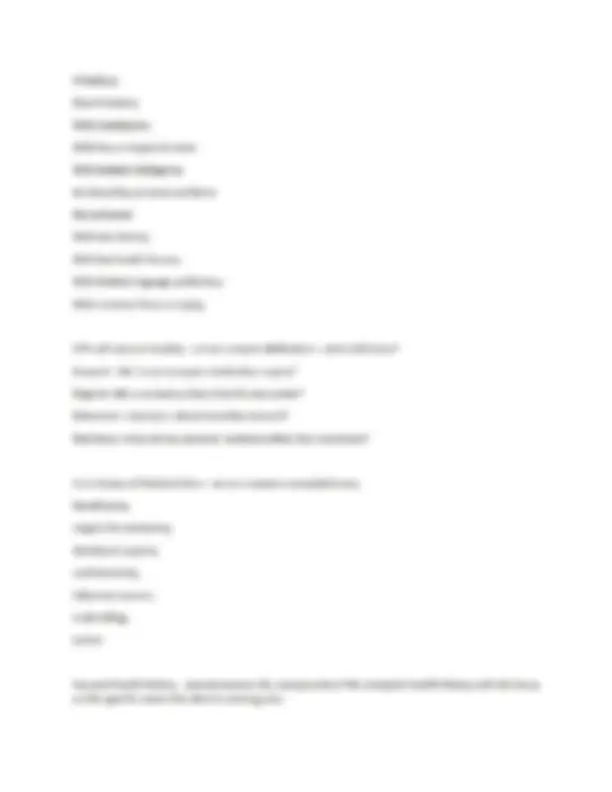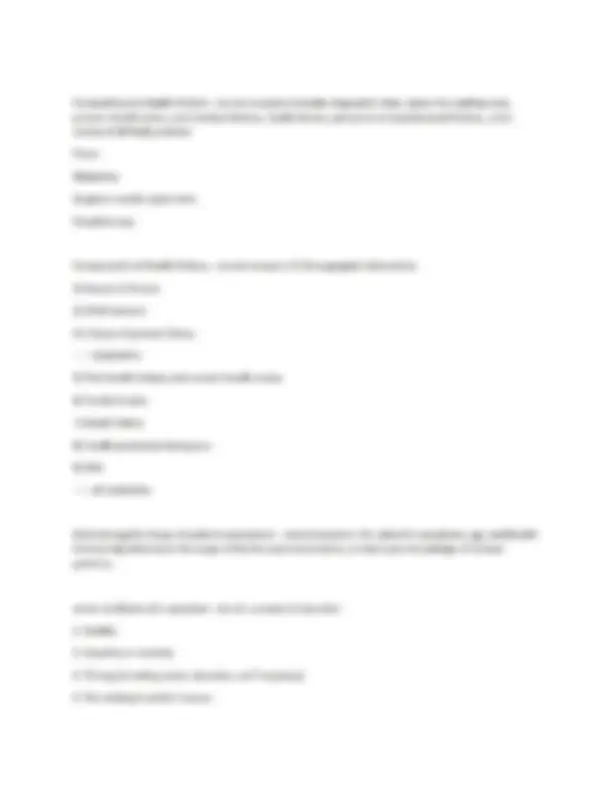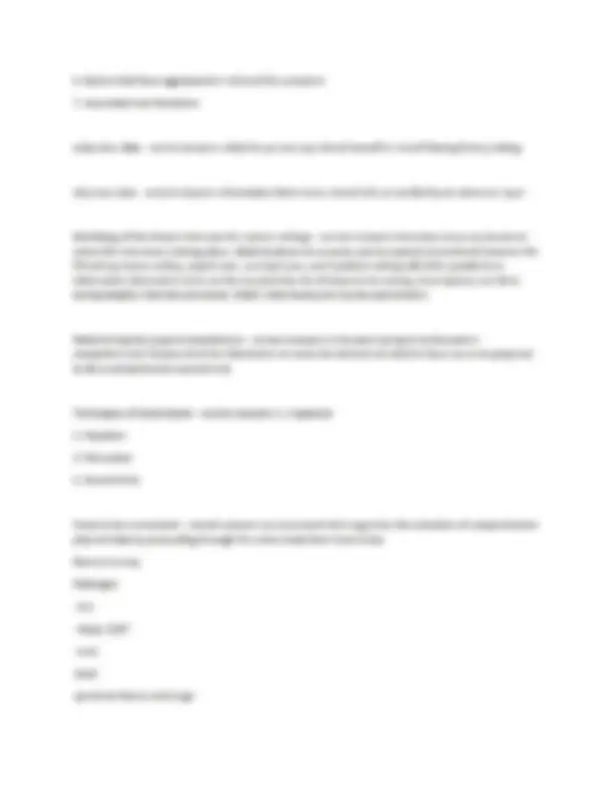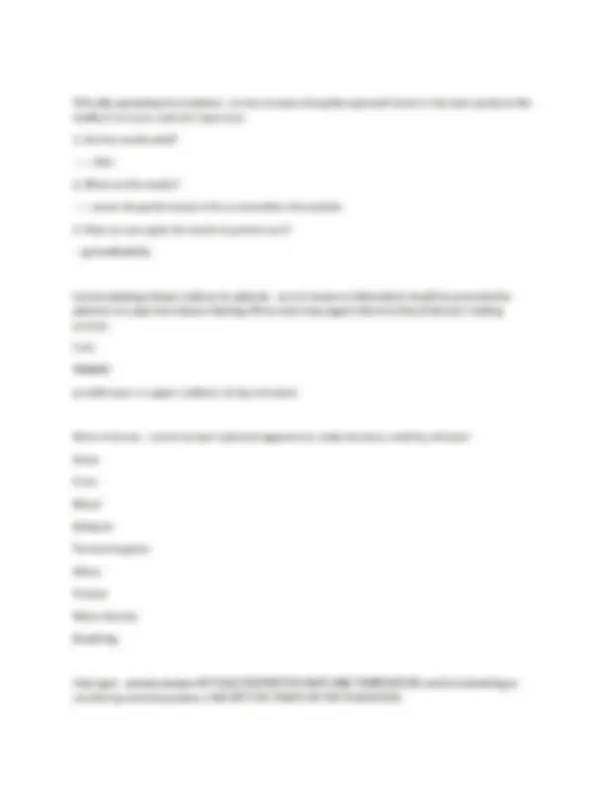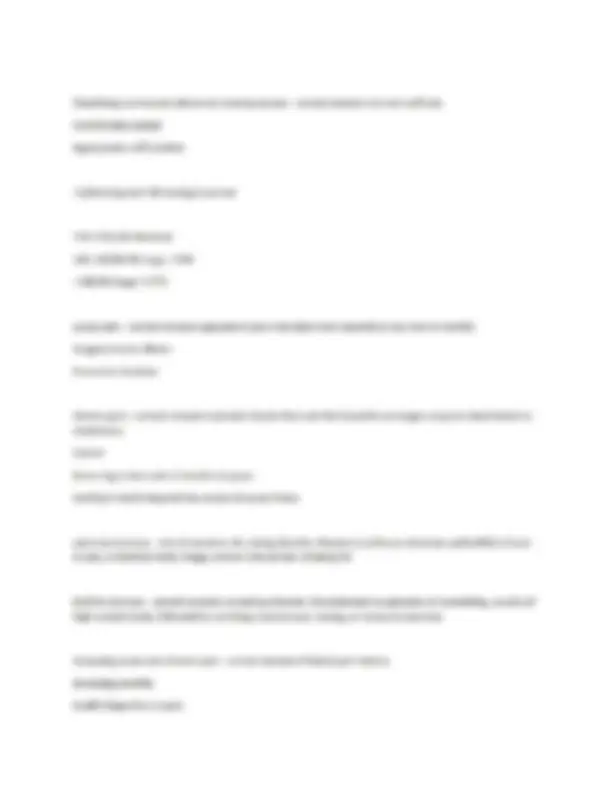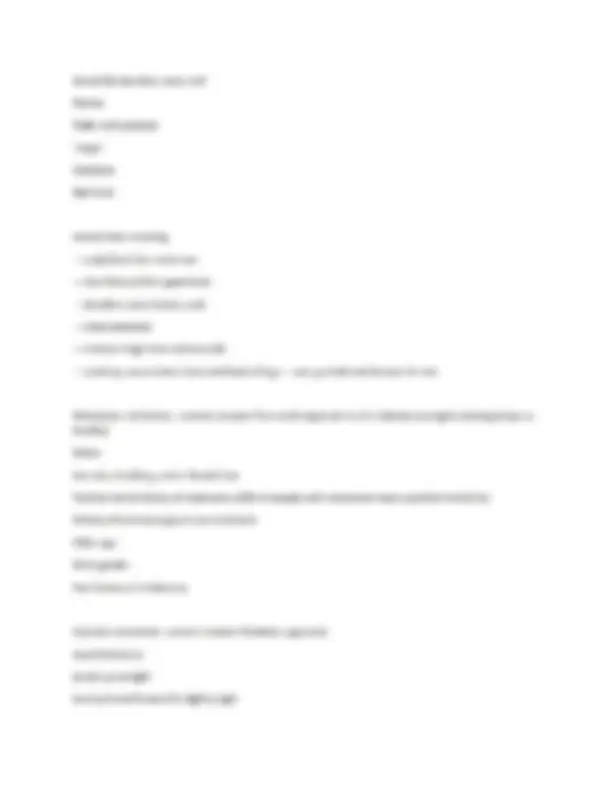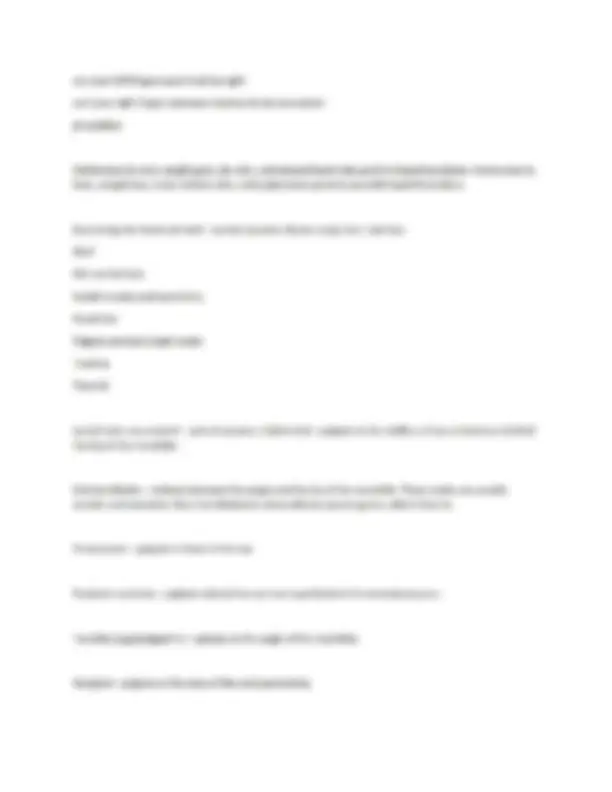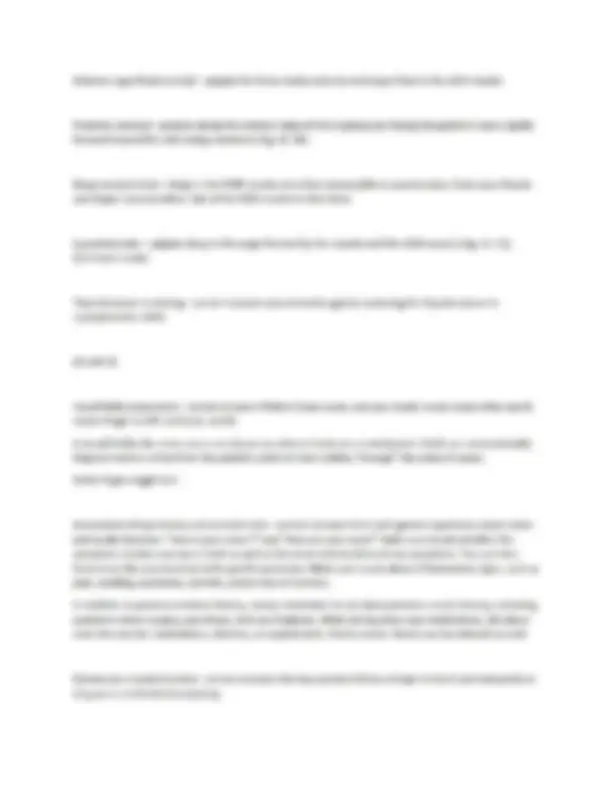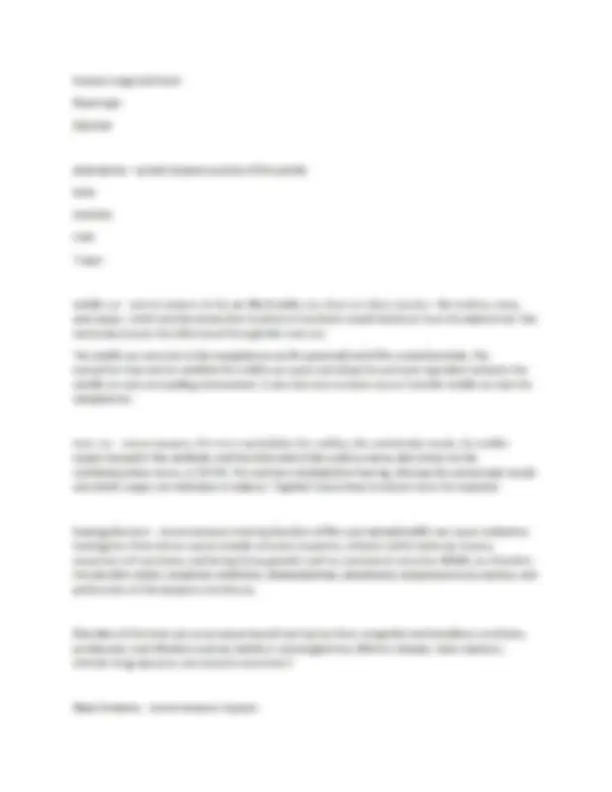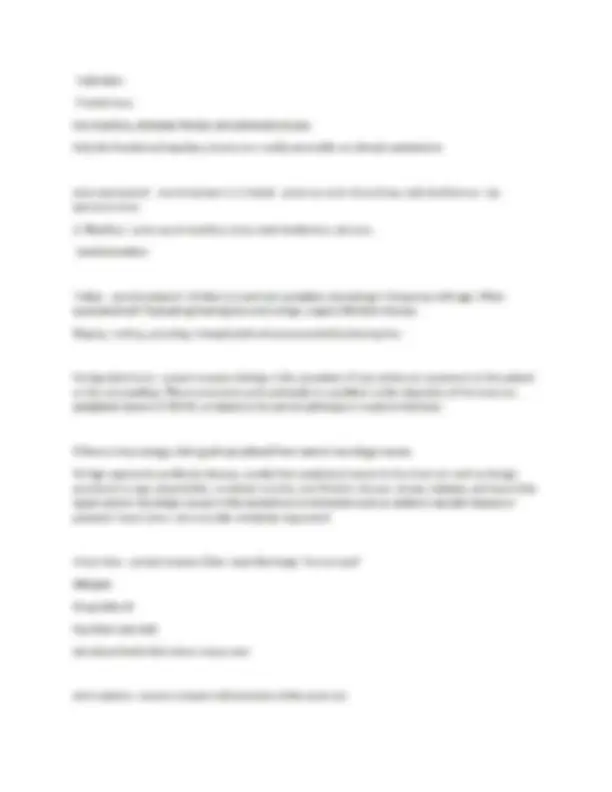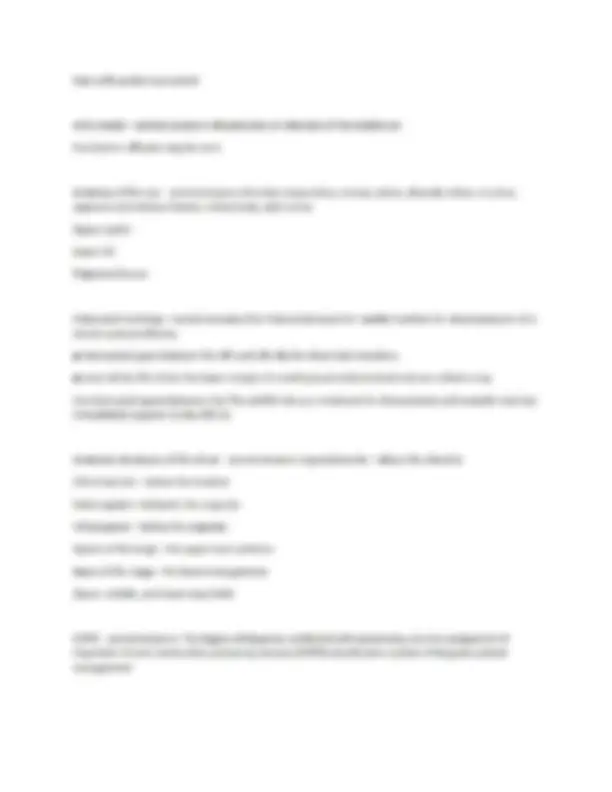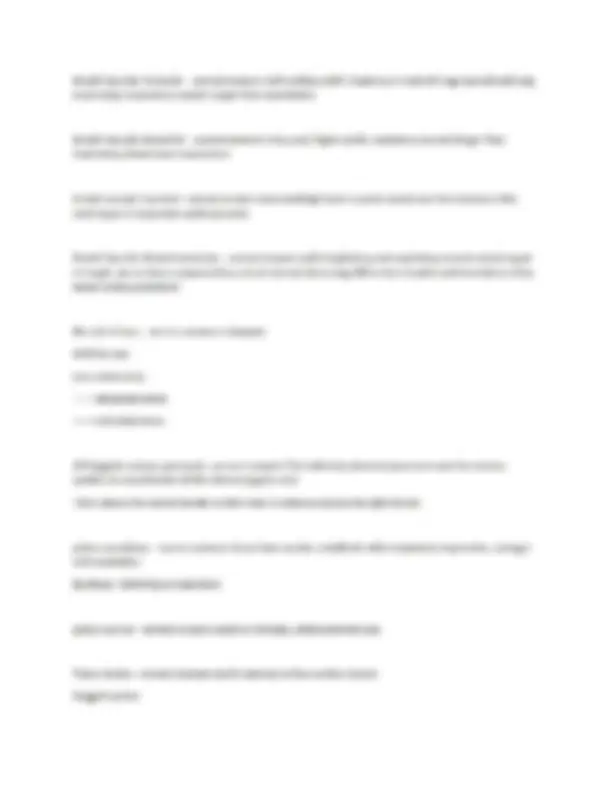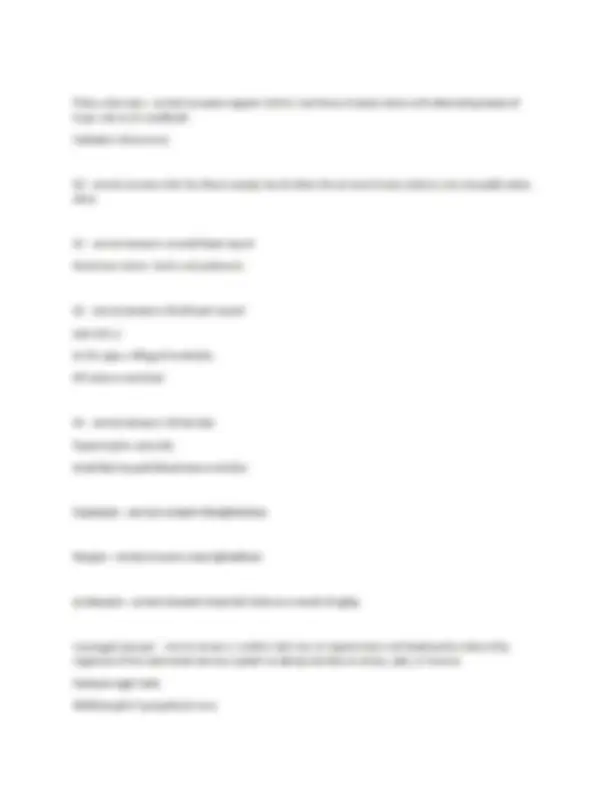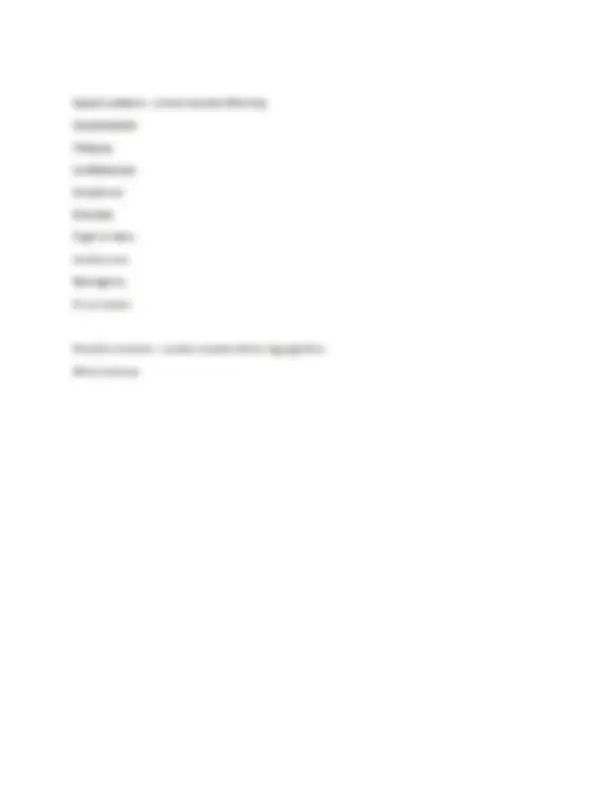Partial preview of the text
Download NR509 ADVANCED PHYSICAL ASSESSMENT MIDTERM WEEK 1-4 QUESTIONS WITH CORRECT DETAILED ANSWER and more Exams Advanced Education in PDF only on Docsity!
The interview process - correct answers-Initiating the session Gathering information Physical examination Explanation and planning Closing the session These steps are proving structure and building the relationship interviewing techniques - correct answers-Nonverbal communication Empathy Active listening Validation reassurance partnering summarize Guided questioning Empowerment Setting the stage for examination - correct answers-Explaining point for point what the examination will entail, preparing, privacy, awareness of the setting in which the exam is taking place, do not assume it is ok to have others in the room, being aware of disabilities. Establishing Rapport - correct answers-Earning trust, following through, showing empathy and compassion, being knowledgeable of the information provided Gender Pronouns - correct answers-How a person would like to be referred to. Ex: "She/Her" "He/Him" "They/Them" etc. How would you describe your sexual identity How would you describe your gender identity What is the sex on your original birth certificate FIFE model - correct answers-Feelings Ideas Functioning Expectations Helps explore the patient's perspective about their health and illness Patient-centered medical care - correct answers-Involving the patient in their care and coming up with a plan with the provider. Provider must acknowledge their own personal biases while being aware of what is the safest Sam's most effective plan for the patient Fundamentals of skilled interviewing - correct answers-Active listening, empathetic responses, guided questioning, nonverbal communication, validation, reassurance, partnering, summarization, transitions, empowering the patient verbal communication - correct answers-expressing ideas to others by using spoken words nonverbal communication - correct answers-communication using body movements, gestures, and facial expressions rather than speech Challenging Patient Situations and behaviors - correct answers-Silent Talkative With confusing narrative With altered state or cognition With emotional lability Angry or aggressive Comprehensive Health History - correct answers-includes biographic data, reason for seeking care, present health status, past medical history, family history, personal and psychosocial history, and a review of all body systems Psych Obstetrics Surgery c-section goes here Hospital stays Components of Health History - correct answers-1) Demographic information 2) Source of history 3) Chief concern 4) History of present illness ——OLDCARTS 5) Past health history and current health status 6) Family history 7) Social history 8) Health promotion behaviors 9) ROS ——all subjective Determining the Scope of patient assessment - correct answers-The patient's symptoms, age, and health history help determine the scope of the focused examination, as does your knowledge of disease patterns. seven attributes of a symptom - correct answers-1. Location 2. Quality 3. Quantity or severity 4, Timing (including onset, duration, and frequency) 5. The setting in which it occurs 6. factors that have aggravated or relieved the symptom 7. associated manifestations subjective data - correct answers-what the person says about himself or herself during history taking objective data - correct answers-information that is seen, heard, felt, or smelled by an observer; signs Modifying of the clinical interview for various settings - correct answers-Interviews may vary based on where the interview is taking place. Ideal situations are a quiet, uninterrupted environment however the ER setting, home setting, urgent care, nursing home, and inpatient setting will differ greatly from information obtained to what can be visualized by the clinician in the setting. Interruptions are likely during lengthy interview processes. Watch interviewing during the examination. Determining the scope of examination - correct answers-Is the exam going to be focused or comprehensive? Review chart for information to make the decision on what to focus on or be prepared to do a comprehensive assessment. Techniques of Examination - correct answers-1. Inspection 2. Palpation 3. Percussion 4. Auscultation Head to toe assessment - correct answers-an assessment that organizes the collection of comprehensive physical data by proceeding through the entire body from head to toe General survey Vital signs -skin - head, EENT -neck -back -posterior thorax and lungs With competing possibilities and select the most likely Dx Pertinent positives-support Dx Pertinent negatives —r/o Dx The summary statement - correct answers-Chief complaint is placed in context of pt's overall heath status Includes pertinent parts of H&P and labs Succinct and short Demonstrates clinical reasoning skills Make case for diagnosis Distillation of ur understanding of the case Assessment (medical diagnoses) - correct answers-Supports what Dx you are going to use and helps w plan development Planning (treatment and interventions) - correct answers-What you plan to do to treat the diagnosis Teaching, meds, exercise, diet, next follow up, recording of home monitoring I.e. BP, pulse, weight, blood sugars, keeping journals for events that occur, what you ate, when you take pain meds. Using elements of the physical examination as diagnostic tests - correct answers-Elicited through the classic techniques of inspection, palpating, percussion, and auscultation. Evaluating diagnostic tests - correct answers-Validity of the findings Reproducibility off the results SnNOUT ——-a sensitive test with negative result RULES OUT disease SpPIN ——-a specific test with a positive result RULES IN disease. Clinically appraising the evidence - correct answers-Using the approach found in the Users guide to the medical literature, and ask 3 questions 1. Are the results valid? ——-bias 2. What are the results? ——assess the performance of tx or prevention intervention 3. How can you apply the results to patient care? —generalizability Communicating clinical evidence to patients - correct answers-Information should be presented to patients in a way that reduces framing effects and encouraged informed shared decision-making process. SA's FRAMES provide ways to support patients facing treatment General Survey - correct answers-physical appearance, body structure, mobility, behavior Dress Color Mood Behavior Personal hygiene Odors Posture Motor Activity Breathing vital signs - correct answers-BP PULSE RESPIRATORY RATE AND TEMPERATURE useful in detecting or monitoring medical problems AND SETS THE TEMPO OF THE EVALUATION mental status examination - correct answers-appearance, orientation, speech , affact/mood, impulsive/potential for harm, judgement/insight, thought processesses, intellectual functioning Speech patterns of individuals - correct answers-Dysarthria defective articulation Aphasia language disorder Dysphonia impaired volume, pitch, quality ——-Testing for aphasia—- Comprehension Repetition Naming Reading comprehension Writing Broca aphasia—-expressive Wernicke aphasia——receptive Hallucinations - correct answers-false sensory experiences, such as seeing something in the absence of an external visual stimulus Auditory visual olfactory gustatory tactile somatic May not recognize the experience Can occur in dementia delirium ptsd schizophrenia and substance use assessing abstract thinking - correct answers-ask to interpret a proverb Similarities Concrete responses to abstract thinking assessment are common in intellectual disability delirium or dementia and may reflect limited education. Schizophrenias may answer concrete or with personal and bizarre interpretations screening for depression - correct answers-PHQ-9 Geriatric depression scale Beck depression scale Edinburg post natal Screening for substance abuse - correct answers-Audit-c SASQ. CAGE Illusions - correct answers-perceptions that misrepresent physical stimuli Can occur in grief reactions delirium and PTSD OLD CARTS - correct answers-Onset Location Duration Characteristics Aggravating and Alleviating Factors Related Symptoms Treatment Severity Techniques of Examination - correct answers-Mental status exam Skin Anatomy (Layers) - correct answers-epidermis, dermis, Vellum and terminal hair Sweat glands skin lesion morphology - correct answers-Assess lesions for skin cancers throughout the examination Be descriptive when describing ABCD Assess for jaundice, eyes, oral Rashes Pallor and cyanosis Turgor Carotene Nail beds Seated then standing —scalp (hair) face neck ears — lean forward for upper back —shoulders arms hands, nails —chest abdomen —anterior thighs feet and toenails —stand up, assess lower back and back of legs—-save genitals and breasts for last Melanoma risk factors - correct answers-Too much exposure to UV radiation (sunlight, tanning lamps or booths) Moles Fair skin, freckling, red or blonde hair Positive family history of melanoma (10% of people with melanoma have a positive family hx) History of immunosuppressive treatment Older age Male gender Past history of melanoma thyroid assessment - correct answers-Posterior approach stand behind pt pt sits up straight bend pt head forward & slightly right use your left fingers push trachea right curl your right fingers between trachea & sternomastiod pt swallow Intolerance to cold, weight gain, dry skin, and slowed heart rate point ta hypothyroidism; intolerance to heat, weight loss, moist velvety skin, and palpitations point to possible hyperthyroidism. Examining the head and neck - correct answers-Assess scalp, hair, hair loss Skull Skin on the face Facial muscles and symmetry Facial hair Palpate cervical lymph nodes Trachea Thyroid Lymph note assessment - correct answers-Submental—palpate in the midline a few centimeters behind the tip of the mandible. Submandibular— midway between the angle and the tip of the mandible. These nodes are usually smaller and smoother than the lobulated submandibular gland against which they lie. Preauricular—palpate in front of the ear Posterior auricular—palpate behind the ear and superficial to the mastoid process. Tonsillar (jugulodigastric)—palpate at the angle of the mandible. Occipital—palpate at the base of the skull posteriorly. Cranial nerves associated with extraocular - correct answers-oculomotor, trochlear, abducens 3,4,6 The abducens nerve (CN VI) innervates the lateral rectus muscle. The trochlear nerve (CN IV) supplies the superior oblique muscle. The oculomotor nerve (CN III) supplies all the rest of the extraocular muscles. visual acuity assessment - correct answers-testing for distance vision, near vision, peripheral vision, and color vision; perform as first step in eye assessment Snellen chart 20ft Cover 1 eye at a time Visual acuity is expressed as two numbers (e.g., 20/30): the first indicates the distance of the patient from the chart, and the second, the distance at which a normal eye can read the line of letters.11 nystagmus - correct answers-a fine rhythmic oscillation of the eyes. A few beats of nystagmus on extreme lateral gaze are normal. If you see this, bring your finger in to within the field of binocular vision and look again. Can be cerebellar ——gait ataxia ——dysarthria (* w retinal fixation) ——vestibular disorder ( decrease w retinal fixation) ——internuclear ophthalmoplegia optical neuritis - correct answers-Sudden vision loss with unilateral and can be painful Associated with MS ICP - correct answers-Papilledema of the optic disc Pink Hyperemic Lose of Venus pulsations Disc more visible swollen blurred edges Headache Blurred vision vomiting behavior changes lack of energy. Sleepiness Catton wool spots - correct answers-Hypertensive retinopathy Diabetes Glaucoma - correct answers-increased intraocular pressure results in damage to the retina and optic nerve with loss of vision Retinal examination reveals pallor and increasing size of the optic cup, which can enlarge to more than half the diameter of the optic disc. Risk factors include age >65 years, African American ethnicity, diabetes, myopia, and ocular hypertension (intraocular pressure [IOP] is 221 mm Hg). macular degeneration - correct answers-progressive damage to the macula of the retina Fundascopic Exam - correct answers-In general health care, examine your patients’ eyes without dilating their pupils. Therefore, your view is limited to the posterior structures of the retina, which can obscure important neurologic findings. Common findings: Retina is visable, arteries and veins, macule, fovea Ear anatomy - correct answers-external ear, middle ear, inner ear Anatomy of thorax and lungs - correct answers-Ribs (12) Sternal angle Costal margins Scapula Spinous process Midsternal, axillary (mid anterior posterior), vertebral, scapular, misclavicukar Trachea and bronchi Turbinates Frontal sinus the maxillary, ethmoid, frontal, and sphenoid sinuses. Only the frontal and maxillary sinuses are readily accessible on clinical examination sinus assessment - correct answers-1. Frontal - press up under bony brow, note tenderness. Tap (percuss) sinus 2. Maxillary - press up on maxillary sinus, note tenderness, percuss. -translumination Tinitus - correct answers-Tinnitus is a common symptom, increasing in frequency with age. When associated with fluctuating hearing loss and vertigo, suspect Méniére disease. Ringing, rushing, pulsating. Unexplained and accompanied by hearing loss Vertigo (dizziness) - correct answers-Vertigo is the sensation of true rotational movement of the patient or the surroundings. These sensations point primarily to a problem in the labyrinths of the inner ear, peripheral lesions of CN VIII, or lesions in its central pathways or nuclei in the brain. If there is true vertigo, distinguish peripheral from central neurologic causes Vertigo represents vestibular disease, usually from peripheral causes in the inner ear such as benign positional vertigo, labyrinthitis, vestibular neuritis, and Méniére disease. Ataxia, diplopia, and dysarthria signal central neurologic causes in the cerebellum or brainstem such as cerebral vascular disease or posterior fossa tumor; also consider vestibular migraine.6 rhinorrhea - correct answers-Clear nasal discharge, "runny nose" Allergies Drug induced Hay fever and viral Ask about foods that induce runny nose otitis externa - correct answers-inflammation of the outer ear Pain with auricle movement otitis media - correct answers-inflammation or infection of the middle ear Purulent or effusion may be seen Anatomy of the eye - correct answers-Includes conjunctiva, cornea, sclera, choroid, retina, iris, lens, aqueous and vitreous humor, ciliary body, optic nerve Upper eyelid Lower lid Palpebral fissure Intercostal markings - correct answers-2nd intercostal space for needle insertion for decompression of a tension pneumothorax. m Intercostal space between the 4th and 5th ribs for chest tube insertion. m Level of the 4th rib for the lower margin of a well-placed endotracheal tube on a chest x-ray. the intercostal space between the 7th and 8th ribs as a landmark for thoracentesis with needle insertion immediately superior to the 8th rib. Anatomic structures of the chest - correct answers-Supraclavicular—above the clavicles Infraclavicular—below the clavicles Interscapular—between the scapulae Infrascapular—below the scapulae Apices of the lungs—the uppermost portions Bases of the lungs—the lowermost portions Upper, middle, and lower lung fields COPD - correct answers-The degree of dyspnea, combined with spirometry, is a key component of important chronic obstructive pulmonary disease (COPD) classification systems that guide patient management 
